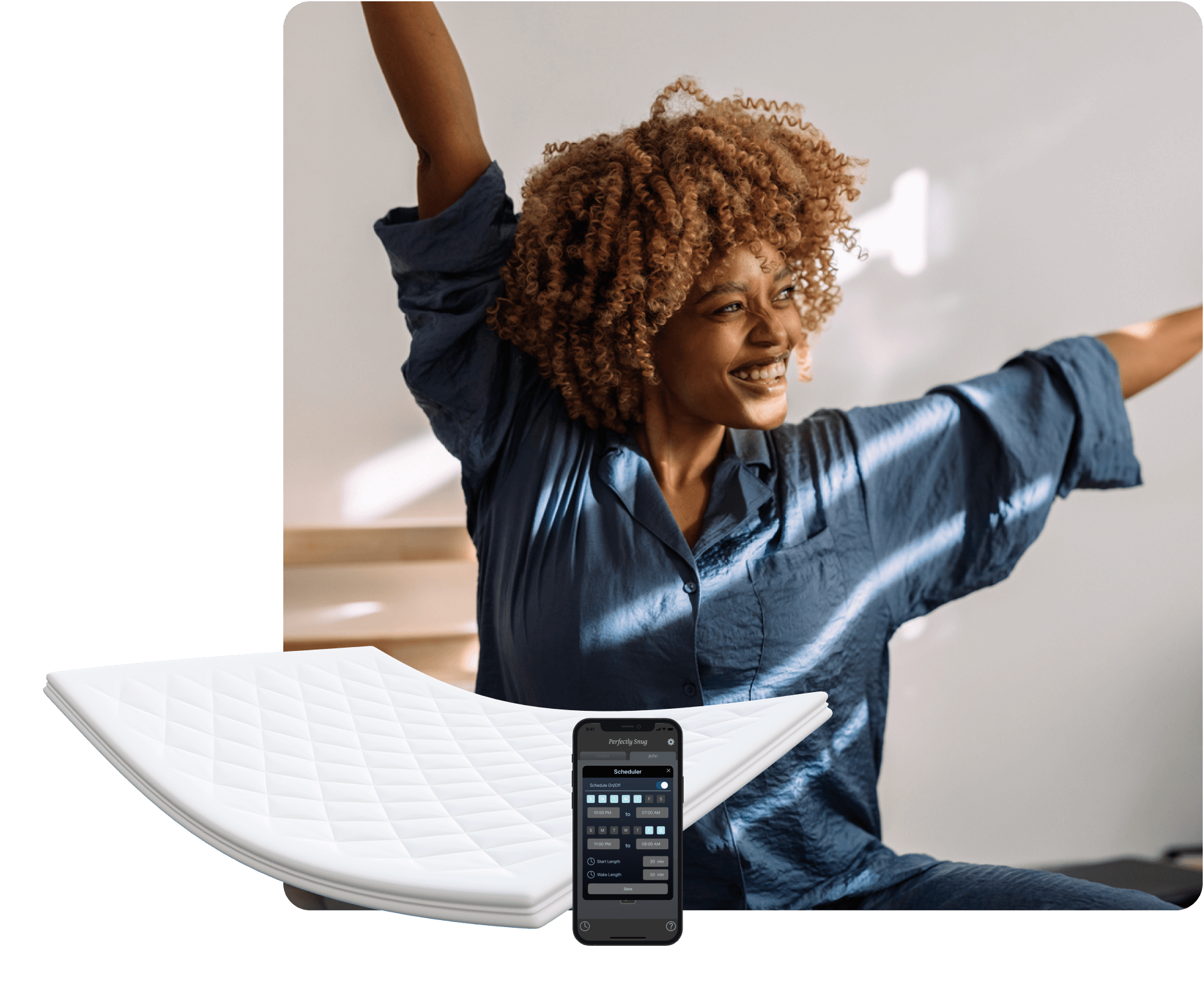Introduction
Sleep – that elusive state we all crave, yet sometimes struggle to achieve. At Perfectly Snug, we understand the importance of a good night's rest. We've designed our Smart Topper to provide the optimal sleep environment, but we know there's more to quality sleep than just temperature control. That's why we're diving into the world of sleep-enhancing sounds, specifically white noise and pink noise. Many of us toss and turn, counting sheep until the wee hours of the morning. If you're one of the millions struggling with sleep issues, you're not alone. The quest for better sleep has led to numerous solutions, from meditation apps to blackout curtains. Among these sleep improvement techniques, white noise and pink noise have gained popularity as potential sleep aids. But what exactly are white noise and pink noise? How do they differ? And more importantly, how can they help you drift off to dreamland faster and stay there longer? Let's embark on a journey through the soundscape of sleep and discover how these auditory tools might just be the lullaby you've been searching for.Understanding White Noise
White noise is like the Switzerland of sounds – neutral, consistent, and oddly comforting. But what exactly is it?Definition and characteristics of white noise
White noise is a type of sound that contains all frequencies across the spectrum of audible sound in equal measure. Imagine a TV tuned to an unused channel – that's white noise. It's a constant, unchanging sound that masks other noises in your environment. The key characteristics of white noise include:
1. Uniform intensity: All frequencies are represented equally.
2. Consistency: The sound doesn't change or fluctuate.
3. Broadband: It covers a wide range of frequencies.
Benefits of white noise for sleep
White noise can be a powerful ally in your quest for better sleep. Here's how it can help:1. Masks disruptive sounds: By creating a constant background noise, white noise helps drown out sudden sounds that might otherwise wake you up.
2. Creates a sleep-friendly environment: The consistent sound can help signal to your brain that it's time to sleep.
3. Reduces sleep onset latency: Many people find they fall asleep faster when using white noise.
4. Improves sleep quality: Some studies suggest that white noise can lead to more stable sleep throughout the night and help optimize time spent in sleep cycles.
5. Eases anxiety: Sleep and mental health are inherently connected. The steady sound can have a calming effect, helping to quiet a racing mind.
Examples of white noise
White noise isn't just limited to the static of an untuned TV. Here are some common examples:1. Fan noise
2. Air conditioner hum
3. Rainfall
4. Ocean waves
5. Wind rustling through leaves
6. Waterfall sounds
Our air-cooled Smart Topper, while primarily designed for temperature control, also produces a gentle, consistent sound that many of our customers find soothing – a happy coincidence that adds to its sleep-promoting properties!Exploring Pink Noise
If white noise is the vanilla of the sound world, think of pink noise as a slightly more sophisticated flavor – perhaps a vanilla bean gelato. It's similar to white noise but with some key differences that might make it even more effective for sleep.Definition and characteristics of pink noise
Pink noise is a type of noise where the power decreases in higher frequencies. In simpler terms, it has more low frequency components and fewer high frequency components compared to white noise. This results in a deeper, richer sound that many people find more pleasant and natural. Key characteristics of pink noise include:1. Balanced and even sound: While all frequencies are present, lower frequencies are emphasized.
2. Natural-sounding: Pink noise often mimics sounds found in nature.
3. Less harsh than white noise: The reduced high frequencies make it easier on the ears.
Benefits of pink noise for sleep
Pink noise offers several potential benefits for sleep:1. Enhances deep sleep: Some studies suggest that pink noise can increase the amount of time spent in deep, slow-wave sleep.
2. Improves memory: Research has shown that exposure to pink noise during sleep can enhance memory recall the next day.
3. Reduces brain wave complexity: Pink noise may help synchronize brain waves, leading to more stable sleep.
4. Masks low-frequency environmental noises: Pink noise is particularly effective at drowning out rumbling sounds like traffic or snoring.
5. Promotes relaxation: The natural quality of pink noise can create a soothing atmosphere conducive to sleep.
Examples of pink noise
Pink noise is often found in nature. Some common examples include:1. Steady rainfall
2. Rustling leaves
3. Heartbeat sounds
4. Ocean waves lapping at the shore
5. Gentle river flow
6. Soft wind
While our Smart Topper doesn't produce pink noise, its gentle hum combined with its temperature-regulating capabilities can create an environment that's just as conducive to sleep.The Differences Between White Noise and Pink Noise
Now that we've explored white noise and pink noise individually, let's put them head-to-head. Understanding the differences can help you choose the right sound for your sleep needs.Frequency and sound spectrum comparison
The main difference between white noise and pink noise lies in their frequency distribution:White Noise: - Equal power across all frequencies - Includes high-pitched sounds - Can sound harsher or more artificial
Pink Noise: - Power decreases as frequency increases - Emphasizes lower frequencies - Sounds more natural and balanced To visualize this, imagine a piano.
White noise would be like playing all the keys at once with equal intensity.
Pink noise would be like playing all the keys, but with the lower notes slightly louder than the higher notes.
Impact on sleep quality: White Noise vs. Pink Noise
Both white noise and pink noise can improve sleep, but they might do so in slightly different ways:White Noise:
- Excellent at masking sudden, disruptive noises - May be more effective for light sleepers - Can help reduce the time it takes to fall asleepPink Noise:
- May enhance deep, slow-wave sleep - Could improve memory consolidation during sleep - Might be more pleasant for extended listening While research is ongoing, some studies suggest that pink noise might have a slight edge when it comes to improving sleep quality and cognitive performance. However, individual preferences play a significant role. Some people might find white noise more effective, while others prefer pink noise. At Perfectly Snug, we believe that the best sleep solution is the one that works for you. Our Smart Topper, with its customizable temperature settings, can work in harmony with either white or pink noise to create your ideal sleep environment.How to Use White Noise and Pink Noise for Better Sleep
Now that you're well-versed in the world of sleep-enhancing sounds, you might be wondering how to incorporate them into your bedtime routine. Here are some tips to help you get started.Choosing the right noise machine or app
When selecting a method to introduce white or pink noise into your sleep environment, consider the following options:1. Dedicated noise machines: These devices are designed specifically for producing sleep-friendly sounds. Look for ones that offer both white and pink noise options.
2. Smartphone apps: Many apps offer a variety of noise options, including white and pink noise. Some even have timers and mixing features.
3. Smart speakers: If you have a smart speaker, you can often ask it to play white or pink noise.
4. Fan or air purifier: These devices can double as white noise machines.
5. Online videos: There are many long-duration white and pink noise videos available online.
Remember, while these sound solutions can be incredibly helpful, they work best when combined with a comfortable sleep environment. Our Smart Topper can provide the perfect foundation for your sound-enhanced sleep experience.Tips for incorporating noise into your bedtime routine
1. Start early: Begin playing your chosen noise about 30 minutes before bedtime to help signal to your body that it's time to wind down.
2. Find your ideal volume: The sound should be loud enough to mask disruptive noises, but not so loud that it becomes disruptive itself.
3. Be consistent: Use your chosen noise every night to help establish a sleep-inducing routine.
4. Experiment: Try both white and pink noise to see which works better for you. You might even find that you prefer different sounds on different nights.
5. Combine with other sleep hygiene practices: Use your noise machine in conjunction with other sleep-promoting habits, like maintaining a cool room temperature (which our Smart Topper can help with), avoiding screens before bed, and sticking to a consistent sleep schedule.
6. Give it time: It might take a few nights for your brain to adjust to the new sound environment. Don't give up if you don't see immediate results.
7. Consider your partner: If you share a bed, make sure your sleep sound choice works for both of you.


